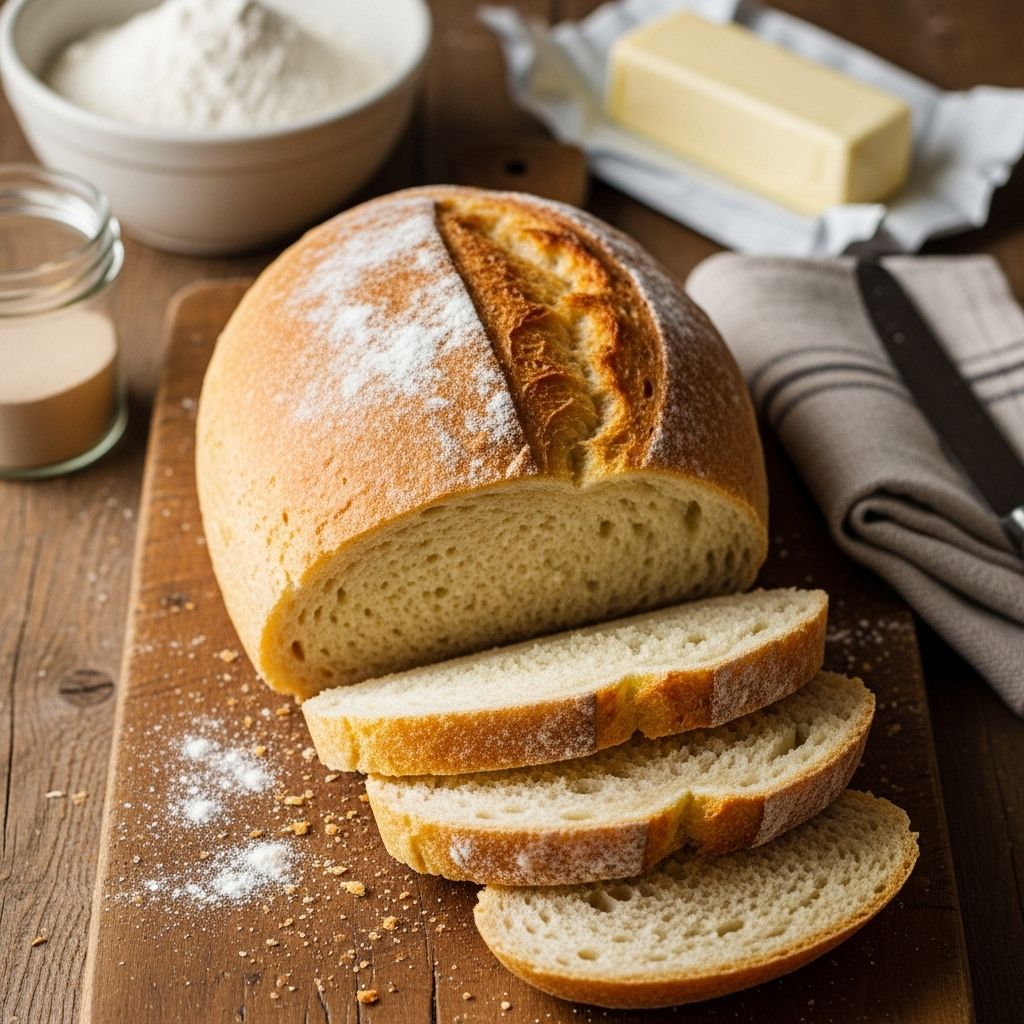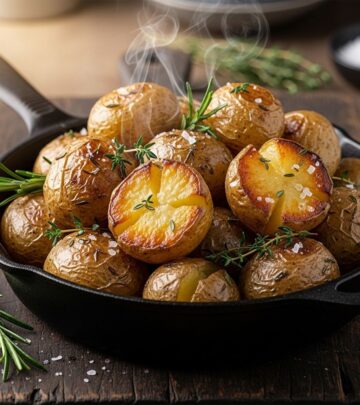Amish White Bread Recipe: 9 Easy Steps For Soft Homemade Loaves
Discover the simplicity and tradition of Amish White Bread—step-by-step homemade baking for soft, delicious loaves every time.

Image: HearthJunction Design Team
Amish White Bread: A Timeless Homemade Staple
Amish White Bread stands as a beloved classic in home kitchens across America. Known for its pillowy softness, tender crumb, and slightly sweet flavor, this bread has become a family staple thanks to its simplicity and reliability. Whether you’re a beginner or a seasoned baker, mastering this loaf means you’ll always have fresh, homemade bread ready to enjoy.
Why You’ll Love Amish White Bread
- Beginner-Friendly: Straightforward ingredients and steps make it accessible for everyone.
- Soft, Tender Texture: Perfect for sandwiches, toast, or just slathering with butter.
- SLightly Sweet and Rich Flavor: The balance of sugar and oil yields a pleasant, mellow taste.
- No Special Equipment Required: You only need basic kitchen tools.
- Feeds a Crowd: This recipe yields two generous loaves, ideal for sharing or freezing.
Ingredients You’ll Need
| Ingredient | Quantity | Notes |
|---|---|---|
| Warm water | 2 cups | 110°F / 45°C |
| White sugar | 2/3 cup | Adds sweetness and feeds the yeast |
| Active dry yeast | 1½ tablespoons | Helps the bread rise |
| Vegetable oil | 1/4 cup | Gives a tender crumb |
| Salt | 1½ teaspoons | Balances sweetness and enhances flavor |
| Bread flour | 6 cups | Provides strength and structure |
Step-by-Step Instructions
- Activate the Yeast:
- In a large mixing bowl, dissolve 2/3 cup white sugar in 2 cups warm water (about 110°F/45°C).
- Stir in 1½ tablespoons active dry yeast. Let sit for 5-10 minutes, until the mixture is creamy and foamy.
- Add the Wet Ingredients:
- Stir 1/4 cup vegetable oil and 1½ teaspoons salt into the yeast mixture.
- Incorporate the Flour:
- Add 6 cups bread flour to the bowl, one cup at a time, mixing well after each addition.
- Continue until a soft dough forms and pulls away from the sides of the bowl.
- Knead the Dough:
- Turn the dough onto a lightly floured surface.
- Knead for about 6–8 minutes, adding more flour if needed, until the dough is smooth and elastic.
- First Rise:
- Place the kneaded dough in a greased bowl, turning to coat.
- Cover with a damp cloth and let rise in a warm spot until doubled in bulk, about 1 hour.
- Punch Down & Shape:
- Punch down the risen dough to release air.
- Knead briefly, then divide into two equal portions.
- Shape each into a loaf and place into two well-oiled 9×5-inch loaf pans.
- Second Rise:
- Cover pans with a damp cloth. Let loaves rise until dough domes about 1 inch above the edge, about 30 minutes.
- Bake:
- Preheat the oven to 350°F (175°C).
- Bake risen loaves for 30 minutes, or until golden brown and hollow sounding when tapped.
- Cool & Serve:
- Remove from pans and cool on wire racks before slicing.
- Enjoy warm or at room temperature, plain or with your favorite spreads.
Expert Tips & Variations
- Flour: Bread flour yields a chewier texture, but all-purpose flour can be used in a pinch—just expect a slightly softer loaf.
- Proofing the Yeast: If the yeast doesn’t foam, it may be old or your water temperature may be off. Always use fresh yeast and lukewarm water.
- Oil Choices: Swap vegetable oil with canola or sunflower oil for a neutral flavor, or use melted butter for extra richness.
- Raising Environment: If your kitchen is cool, let the dough rise in a turned-off oven with the light on or near a sunny window.
- Sweetness: For a less sweet bread, reduce sugar to 1/3–1/2 cup.
- Freezing: This bread freezes beautifully. Once cooled, wrap loaves in plastic and foil and freeze for up to three months.
Serving Suggestions
Amish White Bread is incredibly versatile and perfect for:
- Sandwiches: Its sturdy-yet-soft crumb makes it ideal for both delicate and hearty fillings.
- Toast: Slice and toast for breakfast, slathered with butter, jam, or honey.
- French Toast: Stale slices make the ultimate French toast.
- Soup Side: Serve warm slices with a bowl of soup or stew.
- Simple Snack: A fresh slice with butter is pure comfort.
Storage & Make-Ahead Tips
- At Room Temperature: Store cooled loaves in airtight bags or bread boxes for up to four days.
- Freezing: Slice before freezing to make it easy to thaw individual pieces.
- Reviving: Revive day-old bread by toasting or warming in a low oven for a few minutes.
Amish Baking Traditions: The Story Behind the Bread
The Amish are known for their simple, hearty, and homemade foods—values rooted in community and tradition. Amish White Bread exemplifies these principles, offering a recipe that families have passed down for generations. Often baked in large batches, these loaves are shared with neighbors, enjoyed at family gatherings, or simply served at the dinner table as a daily staple.
Nutritional Information (per slice, approx.)
| Calories | Fat (g) | Carbs (g) | Protein (g) | Sugar (g) |
|---|---|---|---|---|
| 100 | 1.5 | 20 | 3 | 3 |
Values are estimated and will vary based on exact ingredients and loaf size.
Frequently Asked Questions
Q: Can I make this recipe without a stand mixer?
A: Absolutely. Amish White Bread is traditionally made by hand, and the dough is easy to knead on a floured surface. A stand mixer with a dough hook is convenient but not necessary.
Q: My bread didn’t rise. What went wrong?
A: The most common culprits are inactive yeast or too cool rising conditions. Make sure your yeast is fresh and the water temperature is between 105-115°F (40-46°C). Let dough rise in a warm, draft-free environment.
Q: Can I use all-purpose flour instead of bread flour?
A: Yes, you can substitute an equal amount of all-purpose flour. The bread will be slightly less chewy but still soft and delicious.
Q: How do I know when the bread is done baking?
A: The top should be golden brown, and tapping the bottom of the loaf should produce a hollow sound. Internal temperature should read around 190°F (87°C) if checked with a thermometer.
Q: Is it possible to make this bread vegan?
A: Yes! The recipe is naturally dairy-free and contains no eggs. Just ensure your sugar is vegan-friendly.
Reader Tips and Variations
- Milk Bread: Substitute half the water with milk for a richer, softer loaf.
- Seeded Loaves: Sprinkle sesame, poppy, or flax seeds on top before baking for extra texture.
- Whole Wheat: Swap up to 2 cups of bread flour for whole wheat flour for a heartier flavor and nutrition boost.
- Herbs and Flavors: Add dried herbs, garlic powder, or shredded cheese for flavored loaves.
Troubleshooting & Pro Tips
- Sticky Dough? Add flour just a tablespoon at a time while kneading, to avoid tough loaves.
- Dense Bread? Make sure to knead thoroughly and allow enough time for rising.
- Crust Too Hard? Brush freshly baked loaves with melted butter for a softer crust as they cool.
Conclusion: Amish White Bread in Your Kitchen
Homemade Amish White Bread is more than just a recipe—it’s a celebration of tradition, comfort, and the shared joy of baking. With its simple steps, pantry-friendly ingredients, and heartwarming flavor, this bread is sure to become a favorite in your home. Whether you’re baking for your family, gifting a loaf to friends, or simply enjoying a slice fresh out of the oven, you’re keeping a beautiful baking tradition alive.
References
Read full bio of Anjali Sayee












